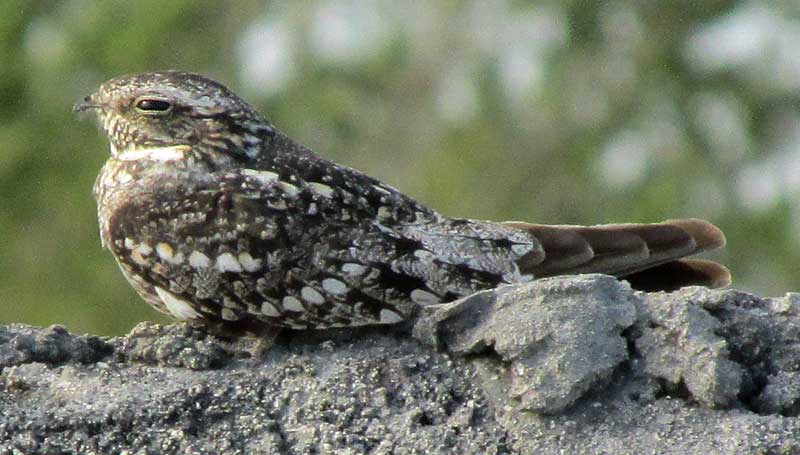Excerpts from Jim Conrad's
Naturalist Newsletter

from the April 5, 2015 Newsletter issued from Río Lagartos, on the Yucatan Peninsula's northern coast (~N21.60°, ~W88.16°), Yucatán state, MÉXICO
LESSER NIGHTHAWK
The cemetery on the south side of Río Lagartos is surrounded by a high stone wall, and occupies low land that just beyond the wall is flooded during the rainy season. Now deep into the dry season the whole area is dry, dusty and mostly open, with scattered bushes, small trees, agaves and cacti. As you walk around the cemetery perimeter you're likely to scare up one or more streamlined-looking birds that fly low and fast, but which quickly land, maybe atop the church wall, like the one shown above.
Once the birds have settled someplace, either on the ground or atop the wall, they sit there unmoving, depending on their camouflage to hide them. If you've seen one land nearby in bushes, probably when you go looking for it you won't see it until it flies up again. These birds' ability to blend into the background is uncanny. But, of course, if they land atop the wall displaying their silhouettes, they're easy to spot. During their evolution, cemetery walls didn't exist, so their instincts say nothing about the wisdom of wall sitting.
Despite having a good picture of a wall sitter to work with, I had to work a little to identify these birds. Here in the northern Yucatan during migration -- and migration has begun -- we can expect five or six species of the Nighthawk or Nightjar Family, to which these birds belong. In North America, Common Nighthawks and Whip-poor-wills are the best known members of the family, and those species are typical of the whole lot. All display variously speckled, blotchy, brown/gray plumage that from the distance looks like dry leaves on the ground, and all have tiny mouths that open wide when they're about to gulp down a flying insect. Normally the gulping is nocturnal, mostly at dawn and dusk.
Our wall-sitting bird doesn't perfectly match any illustration in my field guides, but with those three lines of white spots on the wings, and through the process of elimination, it's clear that this is the Lesser Nighthawk, CHORDEILES ACUTIPENNIS, widely distributed from the southwestern US south through all of Mexico and Central America, to northern South America. With such a big distribution, the species has fractured into seven recognizable subspecies. Ours is ssp. texensis.
Though in North America Lesser Nighthawks are only summer residents, we have them year-round in the northern Yucatan. This January one evening Paco and I were returning on a particularly late flamingo-viewing tour when darkness overcame us with our boat still several miles from town. Suddenly fifteen or twenty Lesser Nighthawks gathered around our boat, their white wing bars barely visible in the darkness, and for a mile or so they followed us, their silent silhouettes circling and darting in and out of our sphere of vision. Often I've wondered why they did that, and sometimes I've imagined that it was just for fun, or that they were curious and wanted to watch us awhile.
Lesser Nighthawks nest mostly where there's arid lowland scrub and/or farmland, of which we have plenty around here.